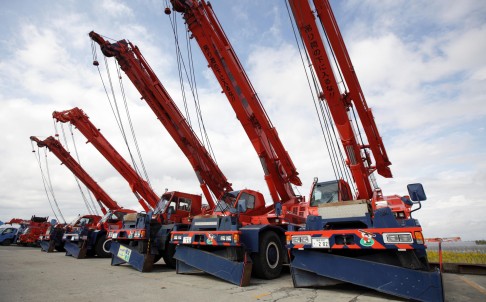Chinese machinery makers look to emerging markets
Oct 31, 2013
When Guangxi Liugong Machinery was bidding to sell wheel loaders to a Thai rice merchant a few years ago, company president Zeng Guangan knew he needed to customise his equipment to beat off Komatsu and other Japanese rivals.
"Thailand has been using Japanese wheel loaders for years," Zeng said. "The seating was getting higher and higher, but the vehicle's arm wasn't long enough."
That works for loading dirt or concrete blocks but was unwieldy for hauling rice.
Liugong's modifications won over buyers, and the Guangxi-based firm says it now makes one of every three wheel loaders sold in Thailand.
It has also increased its marketing in Brazil, Russia, India and Turkey, helping increase overseas revenue to 30 per cent of its total sales - up from less than 9 per cent in 2010.
Other Chinese machinery makers, including Sany Heavy Industry, Zoomlion Heavy Industry Science and Technology and XCMG Construction Machinery, are also turning to emerging markets for growth as they wrestle with cut-throat competition at home.
The rivalry is exacerbated by a supply glut, partly a legacy of heavy stimulus spending in the wake of the global financial crisis.
Meanwhile, Caterpillar and Komatsu say China remains a bright spot in a global market suffering from a downturn in orders for mining equipment.
While the global market is forecast to grow to US$189 billion by 2017, the world's two leading equipment makers cut their full-year profit outlooks this month.
"Market demand [in China] may not be falling as much as before, but the industry has yet to feel the breezes of spring," said Shi Yang at British-based industry consultancy Off-Highway Research.
"Foreign companies' clients in China are mostly big state enterprises, and their business tends to be more stable."
Chinese equipment makers are gaining traction overseas, pulled by the construction boom under way in Southeast Asia and South America, where building of new homes and infrastructure has raised demand for affordable earth-moving equipment.
In the year's first half, Sany's sales outside China rose two-thirds from a year earlier, with growth in the Asia-Pacific up more than 90 per cent. Zoomlion - its annual sales of close to US$8 billion make it the world's No 6 construction machinery maker - made breakthroughs in Thailand, Chile, Costa Rica and Ecuador with its truck-mounted concrete pumps and concrete mixing plants.
"Emerging markets represent a good opportunity when domestic demand is weak," said Xu Mingle, an analyst with BOC International.
"Even though export volumes remain small and cannot offset the slump at home, it at least cushions the blow."
While Caterpillar, Komatsu and Volvo remain dominant in most emerging economies, Chinese equipment is making inroads.
In 2011, XCMG won a US$745 million bid to supply cranes, concrete pumps, excavators and other equipment for a housing project in Venezuela that Caterpillar also bid for.
A year earlier, Liugong beat Caterpillar, Komatsu and South Korea's Hyundai Heavy Industries and Doosan Heavy Industries & Construction to provide wheel loaders and excavators for an afforestation campaign in Turkey, Liugong vice-president Luo Guobing said.
"Chinese companies are certainly not yet the largest in these markets, but they're getting really aggressive," said Raymond Tsang, a Shanghai-based partner at consultancy Bain & Co.
Encouraged by the rising popularity of Chinese equipment, Samcorp, a Hong Kong-based dealer, started selling Zoomlion's and Lonking's products in Peru three years ago. It recently opened another showroom in Colombia.
"People like these products," said Samcorp director Laurence Lam. "They are almost as good as those made by Western companies, but 30 per cent cheaper."
Chinese equipment manufacturers are also gaining access and recognition in emerging markets because they have improved their component sourcing, according to Hermann Beck, an executive vice-president at ZF Friedrichshafen. Besides the German parts maker, Chinese firms are turning to Eaton and Cummins for parts, he said.
There have also been offshore acquisitions. Over the past five years, Chinese firms have bought a variety of struggling European equipment makers, including Italy's CIFA, Germany's Putzmeister and Poland's Huta Stalowa Wola, which has boosted access to eastern Europe.
Industry executives caution that it will take time for Chinese companies to compete against global giants such as Caterpillar, which operates at the higher end of the value chain and books about 65 per cent of its sales outside North America.
"They're going to have to learn how to be domestic players around the world, the way we did," said Ron DeFeo, the chairman and chief executive of Terex, which now increasingly faces Chinese companies in emerging markets. "You can't just make it in China and ship it abroad."
Source: South China Morning Post
